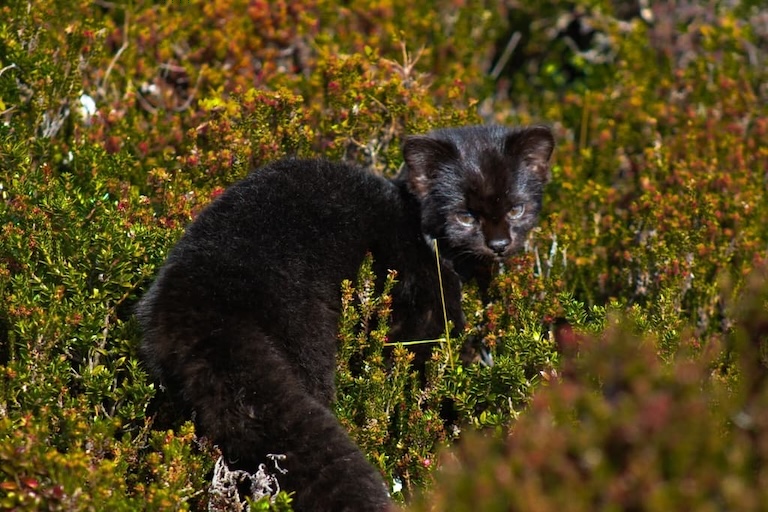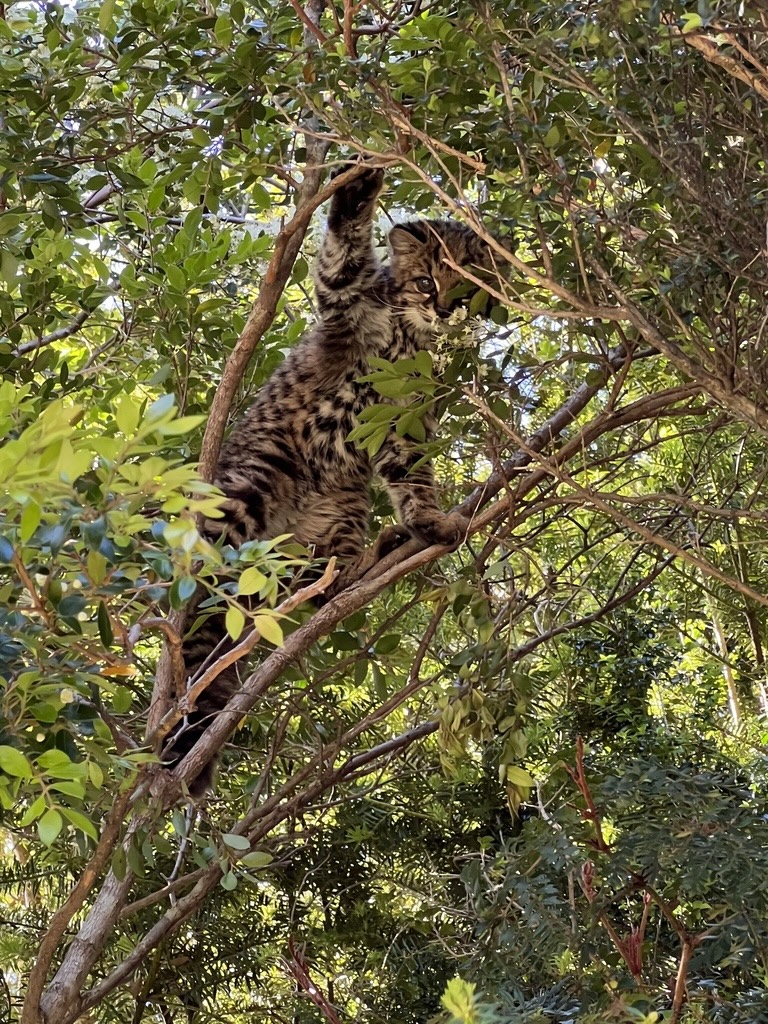Kodkod Profile
In rural Chile, villagers occasionally wake up to their chickens dead, with two little puncture wounds on their necks. This phenomenon has led to vampire concerns in the region, creating anxiety so significant that interventions have had to be held at local schools to draw attention to the truth:
A tiny cat has been implicated in the chicken murders. A cat known locally as the guiña, and hardly known to science at all, the Kodkod.

Kodkod Facts Overview
| Habitat: | Mixed temperate rainforests, bamboo understory |
| Location: | Central and Southern Chile, Argentina |
| Lifespan: | About 6-11 years, 15 + years in captivity |
| Size: | Maximum of about 51cm (20 inches) long |
| Weight: | Maximum 2.5kg (5.5 lb) |
| Colour: | Brownish-yellow to grey-brown with dark spots |
| Diet: | Birds, lizards, rodents |
| Predators: | Culpeo fox, puma, domestic dogs |
| Top Speed: | Unknown |
| No. of Species: | 1 |
| Conservation Status: | Vulnerable (IUCN) |
Kodkods are some of the smallest cats you’ll never see. These elusive little predators live in the bushy undergrowth of the South American rainforests.
Their small size and elusive nature have kept them more or less out of the scientific spotlight, and they’re incredibly hard to study.
Also known as the guiña or guigña, the kodkod is an exceptional predator, especially for its size, and one that’s on the road to extinction before we’ve even really gotten to know it.
Interesting Kodkod Facts
1. They’re small!
The Kodkod is the smallest cat in the Americas and one of the smallest in the world. It’s stocky, with short legs and a thick tail, and inhabits temperate rainforests of Central and Northern Chile and the Patagonian Andes.
This tiny feline has an impressive range which has it roaming bushy undergrowth up to 2500 meters altitude, over a distance of around 25km2 per cat. 1

2. They’re rare
There are two defined races of this cat, with small differences in their colouration. Central and Northern versions are darker with no spots on their legs, and the more Southerly populations appear to be lighter.
Both are very hard to come by and are rarely seen, but there’s a melanistic mutation in this species that’s essentially the holy grail of New World cats. 2
3. They’re excellent predators
Within its habitat, this cat is thought to be a top predator. This is a little surprising for such an unassuming little kitty, but this hunter has some serious chops.
Its diet is made up mainly of mammals, birds and reptiles, but direct observations of hunts are exceptionally rare. In at least one observation, this petite cat was able to bring down a small deer known as a Pudu pudu, suggesting the prey size range of this cat is outstanding among its kind.
4. They are trouble for bird conservationists
This tiny cat is an accomplished climber, able to scale trees and take young birds right out of their nests. This isn’t such a tragedy in an ecological context, but for conservationists aiming to stabilise local bird populations, the cat has proved to be a bit of a problem.
Nest boxes placed in trees are appealing little sanctuaries for bird species targeted for protection unfortunately, they’re also glaring take-away containers for the cat, who has little trouble spotting them from a distance, climbing up and emptying them for dinner.
Not only does this affect the bird populations, but it also totally screws with researchers’ data, as the Kodkod leaves no trace he was ever there, leading to overestimates of breeding successes when they come across an apparently unoccupied nest box. 3
5. They need forest cover
These cats prefer the thicker cover of native forests, but they’re pretty happy to settle for wooded areas, even if the landscape is mostly destroyed. Essentially, they’re looking for complex canopy cover, bamboo, lianas, and epiphytes. If they can find that, they’re happy.
In one study, Kodkods were identified more often in fragments of forest than the continuous forest itself, which suggests that either they gain some benefit from hunting within patchy forests, or that they’re better at hiding when they aren’t restricted to a small patch of trees.
Either way, the study confirms the importance of keeping some wild areas for the local fauna to occupy when flattening the land for agriculture.
6. They’re diurnal, unless someone’s watching
Being small and camouflaged, as well as prone to hiding in the undergrowth, all make this cat difficult to find. But what’s more, they have behavioural adaptations to human presence.
When left alone, and far from people, Chilean cats appear to be quite content hunting in the daytime. In contrast, where human presence intensifies, the cats appear to spend more of their time hunting at night, deliberately avoiding everyone by sheltering up in the trees until after bedtime. 4
7. They’re one of the least-studied felids in the world
The nature of research funding means that most new information that comes out represents only a tiny fraction of data about a small population, somewhere. Added to this slow progress is the compounding factor of this cat being deliberately avoidant, and you’ve got a very difficult PhD.
Rarely do papers make wide-ranging statements about a species, and a cat this hard to spot poses a logistical challenge for researchers to investigate, but from spotty evidence, we can establish what they eat and when, and each little piece of information brings us closer to understanding how to protect such a difficult animal. 5
8. Vulnerable, decreasing
We know that habitat loss is affecting Kodkods because, well, it’s affecting everything. They’re also persecuted directly by humans as competition for human prey animals, and these factors have led to populations being entirely eradicated in some areas in Chile.
Road kills are another increasing threat as the countries the cat inhabits develop further, and human-introduced diseases like Feline Immunodeficiency Virus (FIV) can be passed on from domestic cats as the habitat of the latter encroaches upon that of the Kodkod.
These impacts show no sign of slowing down, and public opinion is not on the side of the wild cat.
9. Conservation is a struggle
Due to the human-wildlife conflict between local people and the chicken-killing Kodkod, this is not a popular animal and conservation is almost impossible without local backing.
Invasive species and other exotic animals have been introduced that have taken precedence over native wildlife, and this little cat is in some cases considered worthless at best, often a dangerous pest in need of eradication.
While it’s protected by the government, illegal killing of this animal appears to be very common.
Conservationists have a hard time convincing locals of the importance of a wild predator when their livelihoods are being directly affected by it, and this is the essence of so many conservation programs for many species, worldwide.
Improved chicken housing, vegetation corridors to link habitats together, and larger protected areas are all areas of focus for the conservation of this species but the progress is easier said than done.

Kodkod Fact-File Summary
Scientific Classification
| Kingdom: | Animalia |
| Phylum: | Chordata |
| Class: | Mammalia |
| Order: | Carnivora |
| Family: | Felidae |
| Genus: | Leopardus |
| Species: | Guigna |
Fact Sources & References
- Melanie Kaiser (2022), “An unusually big challenge: first record of Leopardus guigna preying upon Pudu puda”, Degruyter.
- “Rare species of wild cat caught on camera for the first time”, CNN.
- TOMÁS A. ALTAMIRANO (2013), “Güiña (Leopardus guigna) preys on cavity-nesting nestlings”, redalyc.
- “Chilean cat or Kodkod (leopardus guigna)”, WildCats Magazine.
- M. Delibes-Mateos (2014), “Activity patterns of the vulnerable guiña (Leopardus guigna) and its main prey in the Valdivian rainforest of southern Chile”, Springer Link.
